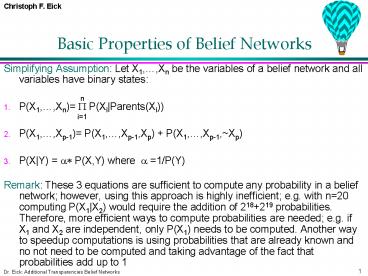Basic Properties of Belief Networks PowerPoint PPT Presentation
Title: Basic Properties of Belief Networks
1
Basic Properties of Belief Networks
- Simplifying Assumption Let X1,,Xn be the
variables of a belief network and all variables
have binary states - P(X1,,Xn) P P(XiParents(Xi))
- P(X1,,Xp-1) P(X1,,Xp-1,Xp) P(X1,,Xp-1,Xp)
- P(XY) a P(X,Y) where a 1/P(Y)
- Remark These 3 equations are sufficient to
compute any probability in a belief network
however, using this approach is highly
inefficient e.g. with n20 computing P(X1X2)
would require the addition of 218219
probabilities. Therefore, more efficient ways to
compute probabilities are needed e.g. if X1 and
X2 are independent, only P(X1) needs to be
computed. Another way to speedup computations is
using probabilities that are already known and no
not need to be computed and taking advantage of
the fact that probabilities add up to 1
n
i1
2
(No Transcript)
3
Big Sur 2006 Plan
Hurricane Point (580 feet)
- Speed Work1
- March 8 t 3x1M (9)
- March 16 t 3x1M (10)
- March 22 t 2.5M
- March 25 mp 7M (12)
- March 29 8k 8x800
- April 2 ct 4x1M
- April 7 8k 10x800
- April 12 ct 3x1.5M
- April 18 t 2x2.5M (11)
- April 22 ct 2x2800
- April 26 30k 3x1M
- Long Runs and Races
- Nov. 19 11.5M
- Nov. 26 14.3M
- Dec. 4 12M
- Dec. 11 16.5M
- Dec. 18 18M
- Dec. 28 20M
- Jan. 6 13Mhi
- Jan. 14 20M
- Jan. 21 22M
- Jan. 30 20M
- Feb. 2005 kind of sick
- March 5 16
- March 12 19
- March 18 21
- March 30 21
- April 9 19
- April 15 17
- April 30 Big Sur Marathon
Bixby Creek Bridge (1932)
Bixby Creek Bridge (110 feet)
4
D-Separation
- Belief Networks abandon the simple independence
assumptions of naïve Bayesian systems and replace
them by a more complicated notion of independence
called d-separation. - Problem Given evidence involving a set of
variables E when are two sets of variables X and
Y of a belief network independent (d-separated)? - Why is this question important? If X and Y are
d-separated (given E) - P(XYE)P(XE)P(YE) and
- P(XEY)P(XE) easy to show how?
- D-separation is used a lot in belief network
computations (see P(DS1,S2) example to be
discussed later) particularly to speed up
belief network computations.
5
D-Separation All paths between members of X and
Y must match one of the following 4 patters
Y
X
E(in E, not in E)
(1a)
(1b)
(2)
(3)
6
D-Separation
A
D
C
B
E
- a) Which of the following statements are implied
by the indicated network structure answer yes
and no and give a brief reason for your answer!
6 - i) P(A,BC) P(AC)P(BC)
- yes, because
- ii) P(C,ED) P(CD)P(ED)
- no, because
- iii) P(CA)P(C)
- no, because
7
Compute P(DS1,S2)!!
S1
D
B
S2
- All 3 variables of B have binary states T,F
- P(D) is a short notation for P(DT) and P(S2D)
is a short notation for P(S2TDF). - Bs probability tables contain P(D)0.1,
P(S1D)0.95, P(S2D)0.8, P(S1D)0.2,
P(S2D)0.2 - Task Compute P(DS1,S2)
8
Computing P(DS1,S2)
- P(DS1,S2)P(D)P(S1D)P(S2D)/P(S1,S2) because
S1D indep S2D - P(DS1,S2)P(D)P(S1D)P(S2D)/P(S1,S2) S1D
indep S2D - (12) 1(P(D)P(S1D)P(S2D)
P(D)P(S1D)P(S2D))/P(S1,S2) - P(S1,S2) P(D)P(S1D)P(S2D)
P(D)P(S1D)P(S2D)g - P(DS1,S2) a / a b with
- aP(D)P(S1D)P(S2D) and b P(D)P(S1D)P(S2
D) - For the example a0.10.950.80.076 and b
0.90.20.20.036 - P(DS1,S2)0.076/0.1120.678
S1
D
S2
9
John/Fred Late Problem
- Assume that John and Fred do not know each other,
but take the same bus to come to UH to attend the
same class moreover, both use an alarm clock,
and will be late to school if their alarm clock
does not work moreover, if the bus is late, both
will come late to school. Assume you have to
model this information using a belief network
that consists of the following variables that
have boolean (true,false) states - John-no-alarm Johns alarm clock does not work
(short JNOA) - Fred-no-alarm Freds alarm clock does not work
(short FNOA) - Bus-late The bus that John and Fred take is late
(short BL) - John-late John is late at school (short JL)
- Fred-late Fred is late at school (short FL)
- Moreover, assume that probability that Johns
alarm clock does not work is 0.02, the
probability that Freds alarm clock malfunctions
is 0.02, and the probability that the bus is late
is 0.1. You can also assume that Fred and John
are on time if their alarm clock works and the
bus they take isnt late. - a) Design the structure of a belief network
that involves the above variables! - b) Using your results from the previous step,
compute P(Bus-latetrueFred-latetrue) !
10
Solution Student Late Problem Ass4
- P(FBLFL) P(FLFBL)P(FBL)/P(FL)1x0.1/P(FL)0.1/
0.117910.848 - P(FL)P(FL,WSF, FBL) P(FL,WSF, FBL)
P(FL,WSF, FBL) P(FL,WSF, FBL) - P(FL,WSF, FBL) P(FL WSF,FBL)P(FBL,WSF)
(because WSF and FBL are d-separable giving no
evidence) P(FL WSF,FBL)P(WSF) P(FBL)
10.010.1 0.001 - Same for the other 3 formulas in (2)
- P(FL) 10.010.1 10.010.9 10.990.1
0.010.990.90.001 0.009 0.099
0.008910.11791
Problem Specification
FBL
FL
MSF
JL
JBL

